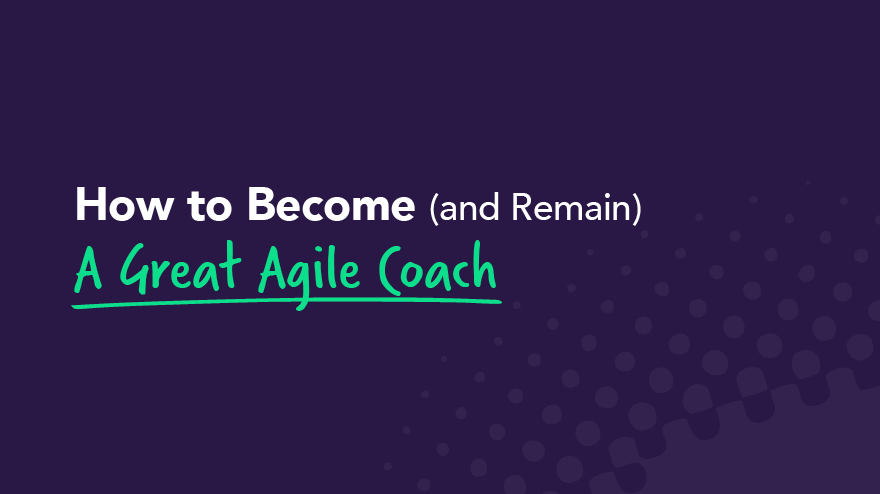Agile best practice
7 min read
How to Become (and Remain) a Great Agile Coach
Mon Jul 22 2024
You're part of an agile team. You know the drill. You have an agile mindset, you and your team members participate in the agile ceremonies, and you use agile tools like Jira. All good! But there's also a good chance that you're part of a larger organization that either doesn't fully grasp agile practices or needs an agile transformation itself. That's where an agile coach can step in.
Let's face it — if your organization was perfectly aligned in its agile framework, you wouldn't be reading this post. 😉 In many large organizations, the adoption of agile practices is limited to a subset of teams, most notably the software development and project management teams.
But you want more — you want to be a master in agile ways. An old saying goes something like, "the best way to learn something is to teach it." Or, as Yoda put it, "Always two there are, no more, no less. A master and an apprentice.”
In this post, we'll explain what's at the core of being an effective agile coach, the differences between an agile coach at the team level vs. the organization level, and a sample path to becoming a certified agile coach. We'll also provide you with some of our best educational resources to keep you sharp no matter what stage of your agile journey you're in.
What is an agile coach?
Let's get one thing out of the way. An agile coach is not an instructor with cat-like reflexes.
Our agile coach provides professional coaching and know-how by helping organizations understand the agile methodology and its benefits well enough to implement it at scale across cross-functional teams. This is provided in two buckets:
- Working with a subset of an organization (teams, managers, and stakeholders) on agile best practices to improve performance and outcomes
- Facilitating organizational change by working with leadership to remove barriers that allow for a full agile transformation
An agile coaching role is not a one-size-fits-all. It can be a permanent or temporary position at a company. Agile coaches come from a variety of backgrounds, including software developer, product owner, Scrum master, and project manager.
An agile coach is a facilitator. Because it is a mentoring role, an agile coach should have competencies in collaboration and communication.
So, you want to be an agile coach
You're all in. You want to expand your agile expertise by teaching its principles or teach agile methods outside of your team. Well, where do you get started? Here's the plan.
Let's tackle it with a three-pronged approach:
- Learning the agile frameworks
- Getting involved in an agile community
- Formal agile training
Learning the agile frameworks
Typically, you want some experience working in agile frameworks before embarking on formal agile coaching certifications. That said, it can be difficult to master the multitude of frameworks within agile development, even over the course of a lengthy career. To whit:
- Scrum
- Kanban
- ScrumBan
- DevOps
- Digital Agile (DA)
- eXtreme Programming (XP)
- Praxis
- Scaled Agile Framework (SAFe)
- Large—Scale Scrum (LeSS)
But wait...there's more! We'll run out of ink if we list them all, so let's move on. ✍️
Many of us spend the majority of our time working with one or two frameworks, or a hybrid of them. For example, you can work for a long time in a Scrum environment before mastering all of the following:
And that's ok! We suggest mastering what you can in your own work environment, like Scrum, then learning as much as you can about another one or two that may interest you that you may not have the opportunity to practice directly. For example, learning about SAFe or LeSS and how they empower agile practices at scale would be a great place to start.
One key tip to keep in mind — it's easy to lose sight of the core principles of agile if you become too mired in practicing frameworks on a day-to-day basis. Every once in a while, close your eyes and go back and read the agile manifesto (ok, you actually need to open your eyes, but you know what we're suggesting):
- Individuals and interactions over processes and tools
- Working software over comprehensive documentation
- Customer collaboration over contract negotiation
- Responding to change over following a plan
You can open your eyes now.
If you're already working within a framework like Scrum with a development team as a Scrum master or product owner, then you probably have a lot of the prerequisites needed to get started in agile coach training courses.
Getting involved in an agile community
Before you apply for an agile coaching certification, it's a good idea to be involved in an agile community. This accomplishes three things:
- It keeps you up-to-date on current happenings in the agile world.
- It exposes you to agile methodologies and ideas that peers are practicing outside in their own organizations.
- It demonstrates that you're committed to practicing agile as a career pursuit — which we'll soon see is important in the application process for becoming a certified agile coach.
You can find agile communities locally or remotely.
Formal agile training
If you want to get hired as an agile coach, it's a good idea to pursue some agile certifications. The most recognizable training courses are offered by the Scrum Alliance. There are two tracks you can take to becoming a Certified Agile Coach, depending on your interest — Certified Team Coach (CTC) or Certified Enterprise Coach (CEC). The are differences between these two tracks that are important to understand:
- A CTC works with multiple agile teams, coaching Scrum masters, product owners, and company managers. A CTC generally sticks to mentoring one area of an organization, such as software development.
- A CEC typically coaches at the executive leadership level at an organization. A CEC is an enterprise agile coach whose goal is to assist an organization in successfully achieving a full agile transformation.
You're probably wondering...how much of a commitment is it to achieve certification? We won't sugarcoat it — it's significant. But that commitment can lead to a career-long ability to have a meaningful impact on teams and organizations. In short, here’s what you need to become a CTC or CEC:
- Be an active Certified Scrum Professional
- Submit a first application describing your agile experience, including team and organization coaching experience, agile community participation, and your use of agile practices
- Submit a second application that evaluates your knowledge, mindset, and approach as a coach and that requires mentor and customer recommendations
- An annual certification fee
- Continuing education requirements to maintain your certification
Great agile coaches keep learning

It can take a long time to build the experience to become an agile coach. After that, it's important to stay in tune with core agile concepts and how they relate to current trends in software development in order to remain knowledgeable enough to maintain your credentials.
We believe our agile resources are as good for continuing education as you can find. Here are some posts that highlight some of the key areas we talked about earlier:
- What's the Difference Between Kanban vs. Scrum?
- Learn Agile First — Then Learn How to Scale It
- Why large enterprises need Scaled Agile Framework (SAFe), not team—level Agile
But wait...there's more! Head over to our blog for our treasure trove of resources — and when you get tired of reading, put on your headphones and tune in to our podcast episode featuring an agile coach.